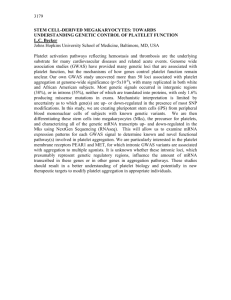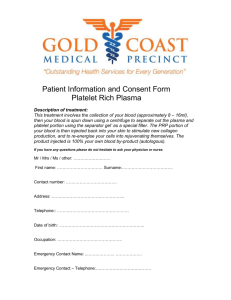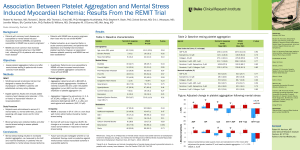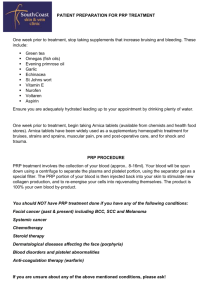Text
advertisement
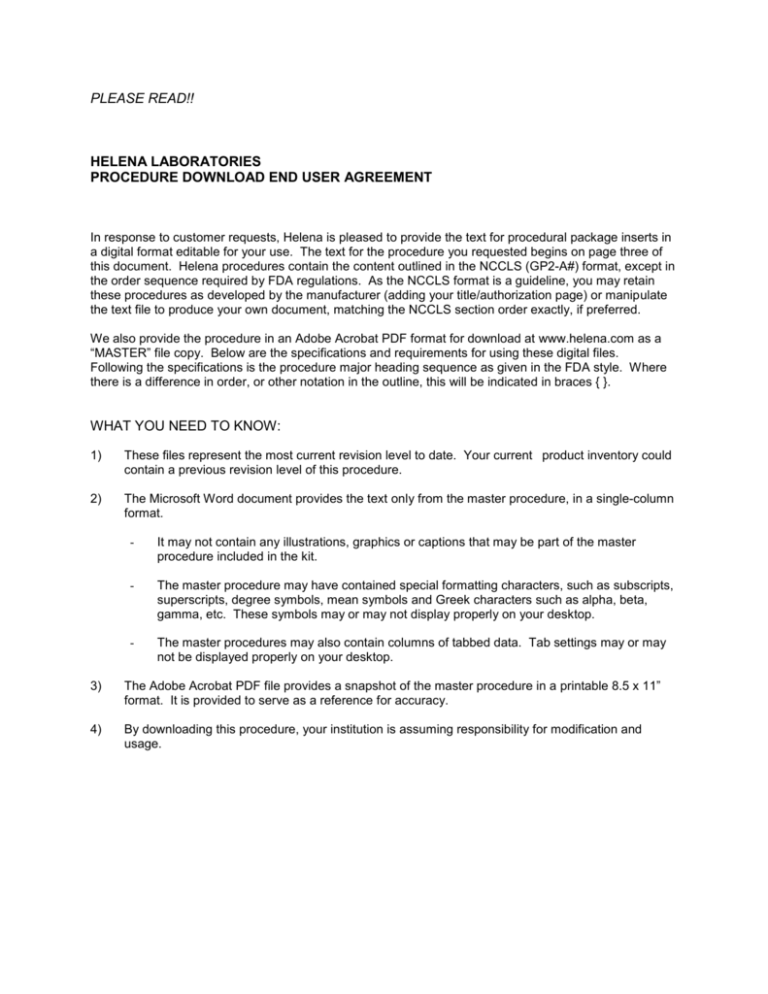
PLEASE READ!!
HELENA LABORATORIES
PROCEDURE DOWNLOAD END USER AGREEMENT
In response to customer requests, Helena is pleased to provide the text for procedural package inserts in
a digital format editable for your use. The text for the procedure you requested begins on page three of
this document. Helena procedures contain the content outlined in the NCCLS (GP2-A#) format, except in
the order sequence required by FDA regulations. As the NCCLS format is a guideline, you may retain
these procedures as developed by the manufacturer (adding your title/authorization page) or manipulate
the text file to produce your own document, matching the NCCLS section order exactly, if preferred.
We also provide the procedure in an Adobe Acrobat PDF format for download at www.helena.com as a
“MASTER” file copy. Below are the specifications and requirements for using these digital files.
Following the specifications is the procedure major heading sequence as given in the FDA style. Where
there is a difference in order, or other notation in the outline, this will be indicated in braces { }.
WHAT YOU NEED TO KNOW:
1)
These files represent the most current revision level to date. Your current product inventory could
contain a previous revision level of this procedure.
2)
The Microsoft Word document provides the text only from the master procedure, in a single-column
format.
-
It may not contain any illustrations, graphics or captions that may be part of the master
procedure included in the kit.
-
The master procedure may have contained special formatting characters, such as subscripts,
superscripts, degree symbols, mean symbols and Greek characters such as alpha, beta,
gamma, etc. These symbols may or may not display properly on your desktop.
-
The master procedures may also contain columns of tabbed data. Tab settings may or may
not be displayed properly on your desktop.
3)
The Adobe Acrobat PDF file provides a snapshot of the master procedure in a printable 8.5 x 11”
format. It is provided to serve as a reference for accuracy.
4)
By downloading this procedure, your institution is assuming responsibility for modification and
usage.
HELENA LABORATORIES
PROCEDURE DOWNLOAD END USER AGREEMENT
HELENA LABORATORIES LABELING – Style/Format Outline
1)
2)
3)
4)
PRODUCT {Test} NAME
INTENDED USE and TEST TYPE (qualitative or qualitative)
SUMMARY AND EXPLANATION
PRINCIPLES OF THE PROCEDURE
{NCCLS lists SAMPLE COLLECTION/HANDLING next}
5)
REAGENTS (name/concentration; warnings/precautions; preparation; storage; environment;
Purification/treatment; indications of instability)
6)
INSTRUMENTS required – Refer to Operator Manual (... for equipment for; use or function;
Installation; Principles of operation; performance; Operating Instructions; Calibration* {*is next in
order for NCCLS – also listed in “PROCEDURE”}’ precautions/limitations/hazards; Service and
maintenance information
7)
SAMPLE COLLECTION/HANDLING
8)
PROCEDURE
{NCCLS lists QUALITY CONTROL (QC) next}
9) RESULTS (calculations, as applicable; etc.)
10) LIMITATIONS/NOTES/INTERFERENCES
11) EXPECTED VALUES
12) PERFORMANCE CHARACTERISTCS
13) BIBLIOGRAPHY (of pertinent references)
14) NAME AND PLACE OF BUSINESS OF MANUFACTURER
15) DATE OF ISSUANCE OF LABELING (instructions)
For Sales, Technical and Order Information, and Service Assistance,
call Helena Laboratories toll free at 1-800-231-5663.
Form 364
Helena Laboratories
1/2006 (Rev 3)
Helena Platelet
Aggregation Reagents
Cat. No. 5366, 5367, 5368, 5369
Helena Platelet Aggregation Reagents are intended for use in platelet aggregometry studies.
SUMMARY
Platelets are disk-shaped cells circulating in the blood that are produced from megakaryocytes in the
bone marrow. These cells participate in formation of the hemostatic plug and are implicated in some
thrombotic events.1
Platelet aggregation is performed to identify abnormal platelet function, to quantitate platelet response,
and monitor platelet inhibition by drug therapy.2
Several platelet aggregating agents include thrombin, collagen, ADP, arachidonic acid, antigen-antibody
complexes, serotonin and vasopressin. It is useful to study these aggregating agents according to their
mode of action. ADP, epinephrine, and vasopressin induce aggregation directly while collagen and
thrombin act as stimulating substances to induce ADP release and thromboxane A2 release.2
This procedure is performed on a turbidimetric aggregometer, as first described by Born. 3 The change in
absorbance is recorded as platelet rich plasma is stirred in a cuvette with aggregating reagents added.
ADP, collagen and epinephrine are reagents commonly used to induce platelet aggregation. Helena
Platelet Aggregation Reagents are stable, sensitive reagents which are conveniently packaged.
PRINCIPLE
In-vivo, platelets participate in primary hemostasis by first adhering and then aggregating at the site of an
injured blood vessel. Platelet aggregation can be followed in-vitro by adding inducers such as collagen,
ADP and epinephrine to stirred platelet rich plasma. The increase in light transmittance is recorded as the
platelets aggregate. The absorbance (OD) change is measured and recorded as the platelets aggregate. 4
REAGENTS
1. ADP (Adenosine diphosphate) Reagent
Ingredients (after reconstitution):
ADP 200 µM
WARNING: FOR IN-VITRO DIAGNOSTIC USE ONLY. DO NOT INGEST.
Preparation for Use: Prepare a stock solution by reconstituting one vial with 1.0 mL of distilled or deionized
water. Mix gently until completely dissolved.
Storage and Stability: The ADP Reagent should be stored in the dry form at 2 to 8°C and is stable until the
expiration date on the vial. The reconstituted reagent is stable for 1 week at 2 to 8°C or three months at -20°C.
The working solutions should be used within three hours of preparation.
Signs of Deterioration: If the dry, unreconstituted reagent is not uniformly white in appearance, it should not be
used.
2. Epinephrine Reagent
Ingredients (after reconstitution):
Epinephrine bitartrate
3mM
WARNING: FOR IN-VITRO DIAGNOSTIC USE ONLY. DO NOT INGEST.
Preparation for Use: Prepare a stock solution by reconstituting one vial with 1.0 mL of distilled or deionized
water. Mix gently until completely dissolved.
Storage and Stability: The Epinephrine Reagent should be stored in dry form at 2 to 8°C and is stable until
the expiration date on the vial. The reconstituted reagent is stable for 1 week at 2 to 8°C.
Signs of Deterioration: If the dry, unreconstituted reagent is not uniformly white in appearance, it should
not be used.
3. Collagen Reagent Ingredients (after reconstitution):
Collagen (equine tendon) 100 µg/mL
WARNING: FOR IN-VITRO DIAGNOSTIC USE ONLY. DO NOT INGEST.
Preparation for Use: The reagent is ready for use. Mix gently in swirling motion before use.
Storage and Stability: The Collagen Reagent is stable in its liquid form in an unopened vial at 2 to 8°C until
the expiration date on the vial. The contents of an opened vial are stable for four weeks at 2-8°C.
Signs of Deterioration: The reagent should appear as a uniform clear suspension once it has been swirled.
If discoloration is noted or the suspension is not uniform, the reagent should not be used.
INSTRUMENTS
Helena Platelet Aggregation Reagents are suitable for use with any turbidimetric aggregation monitoring device.
Recommended is the Helena AggRAM (Cat. No. 1484) or the PACKS-4 (Platelet Aggregation Chromogenic
Kinetic System) (Cat. No. 1471).
SPECIMEN COLLECTION AND HANDLING
Specimen: Plasma obtained from whole blood collected with 3.2% sodium citrate as an anticoagulant is the
specimen of choice.
Specimen Collection: Blood may be collected with evacuated test tubes, a 2-syringe technique, or with a
butterfly and syringe technique. Accurate coagulation studies depend on the correct whole blood to
anticoagulant ratio. For blood specimens with hematocritis (HCT) of <55% (normal), 9 parts of freshly collected
whole blood should be immediately added to one part anticoagulant. For blood specimens with hematocrits
outside the normal range, adjust the amount of whole blood added to the anticoagulant according to the
following formula.6
5
Parts whole blood to
one part anticoagulant
= 0.6
x9
(1- .HCT)
Particular care should be taken when using evacuated test tubes. These tubes are designed to draw 9 parts
blood to 1 part anticoagulant. If the hematocrit is determined abnormal, blood should be drawn into a syringe
and an appropriate amount mixed with an adjusted volume of citrate anticoagulant.
Specimen Preparation:
1. Prepare platelet rich plasma (PRP) by centrifuging both of the anticoagulated samples at 100 x g 10-15
minutes at room temperature. DO NOT BRAKE THE CENTRIFUGE. Remove the PRP from the cells with a
plastic pipette and place in a plastic tube labeled PRP. Cap the tube and maintain at room temperature. Wait
30 minutes after PRP is removed before testing.
2. Prepare platelet poor plasma (PPP) by recentrifuging the remaining blood samples at 1600-2000 x g (or an
equivalent centrifugation force) for 10-15 minutes at room temperature. DO NOT BRAKE THE CENTRIFUGE. Remove PPP, place in a plastic tube labeled PPP and cover. Maintain at room temperature.
3. A platelet count should be performed on the patient PRP and a normal control PRP. The platelet count
should be standardized (usually 250,000/mm 3) by adjusting the PRP with autologous platelet poor plasma.
The control should be run at the same platelet count as the patient samples. If the patient platelet count is
low, the control PRP should be adjusted to the same platelet count. Platelet counts below 100,000/mm 3 may
give variable results.
Storage and Stability: Plasma as well as whole blood should always be stored at room temperature (15-30°C).
Cover samples to maintain the pH. Tests should be performed within three hours after sample collection.
PROCEDURE
Materials Provided:
Platelet Aggregation Kit
ADP Reagent (2 x 1.0 mL)
Collagen Reagent (2 x 1.0 mL)
Epinephrine Reagent (2 x 1.0 mL)
Cat. No. 5369
Cat. No.
ADP Reagent (2 x 1.0 mL)
5366
Epinephrine Regent (2 x 1.0 mL)
5367
Collagen Reagent (2 x 1.0 mL)
5368
Materials Required But Not Provided:
Platelet Aggregometer (AggRAM Analyzer or PACKS-4
Analyzer recommended)
Plastic pipette tips
Plastic or siliconized test tubes
Pipettes to deliver 50 µL or 100 µL
Pipettes to deliver 450 µL or 225 µL
0.85% Saline (preservative free)
STEP BY STEP METHOD
NOTE: The AggRAM and the PACKS-4 can be run with the recommended (standard) volumes or with one-half
(micro) volumes. Standard volume tests are done at 1000 rpm and micro volume tests are done at 600 rpm.
Patient results should be compared to normal ranges run under the same conditions.
The following steps are for standard volume; for micro volume, use one half of the standard volumes.
1. Collect and prepare blood specimen according to directions in SPECIMEN COLLECTION AND HANDLING
section.
2. Reconstitute the aggregation reagents according to the directions in the REAGENT section.
3. ADP, Epinephrine and Collagen reagents should be used undiluted and will have the final concentrations
given below when mixed with the PRP during testing. If other concentrations are desired, make working
solutions with saline.
Final concentration
ADP
20 M
Collagen
10 g/mL
Epinephrine
300 M
4. Prepare aggregometer for use as recommended in the Operator’s Manual.
5. Pipette 450 L of platelet poor plasma (PPP) into a cuvette. This blank will be used to set the 100%
aggregation.
6. Pipette 450 L of platelet rich plasma (PRP) into cuvettes with a stir bar. Incubate the cuvette at 37°C for
one to three minutes.
7. Insert the PPP cuvette into the appropriate channel and set the instrument to 100% aggregation.
8. Iinsert the PRP cuvette into the appropriate channel.
9. Add 50 L of the aggregating reagent dilutions to the PRP cuvette and record the percent aggregation.
(Instrument sets 0% when the aggregating agent is added and the channel activated.)
NOTE: For maximum sensitivity to borderline response, aggregation may be performed with lower
concentrations of reagents. Dilutions of reagents made in 0.85% saline can be used to obtain minimum
concentration required to produce normal aggregation. Each laboratory should establish the optimal range of
dilution for its own instrument, reagent and normal population.
Quality Control: Known normal PRP specimens should be used to establish typical aggregation patterns.
Normal values for these patterns are then compared with the results from samples with marked variation from
the normal range, thus indicating platelet dysfunction.4
RESULTS
The analysis of a platelet aggregation curve is noted by the presence of a primary and secondary wave. Prior to
the addition of an aggregation reagent, random oscillations in the trace are seen. After exposure to the
aggregation reagent, a delay in response, or oscillations, occurs followed by platelet shape changes. This
alteration is the first platelet response to a stimulus and is seen as a decrease in oscillations and an increase in
optical density. Small aggregates of platelets start to form and continue to form larger masses. This is noted by
the ascent of the curve which is termed the primary wave. As the ascent nears completion, the trace may turn
one of two directions. If the “platelet release reaction” occurs, the aggregation process continues to become
irreversible (secondary wave), and the trace will continue to ascend. However, if the release reaction does not
occur, the trace will reverse itself and continue downward to the baseline. This can be caused by aspirin
ingestion 7 to 9 days prior to blood collection.
One of the several methods used to quantitate platelet aggregation is the Weiss formula. It measures the initial
and maximum O.D. to give a result in percent aggregation.8
O.D. Initial -O.D. Maximum
O.D. Initial
x 100 = % Aggregation
Follow the Operator’s Reference Manual for the aggregation monitoring instrument being used.
LIMITATIONS
A patient medical history of all prescriptions and non-prescription drugs should be taken before testing.
Medication, especially aspirin, may interfere with aggregation. For the effects of various drugs on platelet
aggregation activity, refer to Young, et al. 9 Prior to testing, patients should refrain from smoking or drinking, and
if possible, from taking medication.
REFERENCE VALUES
The table below illustrates the results of aggregation studies conducted at Helena Laboratories with a group of
twenty-one normal donors using the Helena PACKS-4 and 50 normal donors with the AggRAM. These should
serve as guidelines for expected values. Because differences may exist among instruments, laboratories and
local populations, it is recommended that each laboratory establish its own range of expected values.
REAGENT
ADP
Collagen
Epinephrine
Combined % Aggregation
Actual Range
77-99
80-98
63-97
Estimated
Range
70-100
70-100
70-100*
*This range is for individuals who exhibit a secondary wave of aggregation and represents the maximum
aggregation observed. A percentage of normal individuals with no known bleeding disorders do not exhibit a
secondary aggregation with epinephrine and their % aggregation is about 20-60%.11
INTERPRETATION OF RESULTS
The following table may be used as a guideline as to abnormal findings in various platelet disorders.
PERFORMANCE CHARACTERISTICS COMPARISON
Studies were done on specimens using the AggRAM and PACKS-4 Analyzers. The results were as follows.
ADP – N = 65
Y = 0.957X + 4.8
r = 0.982
Collagen – N = 66
Y = 1.071X – 2.1
r = 0.978
Epinephrine – N = 64
Y = 0.890 + 8.1
r = 0.955
X = PACKS-4
Y = AggRAM
BIBLIOGRAPHY
1. Zucker, M.B., The Functioning of Blood Platelets, Sci Amer 242(6):86-103, 1980.
2. Marcus, A.J. Platelet Aggregation. Hemostasis and Thrombosis: Basic Principles and Clinical Practice,
Coleman, R.W., Hirsh, J., Marder, V.J., and Salzman, E.W., Ed. J.B. Lippincott Co., Philadelphia, 1982, pg
380-389.
3. Born, G.V.R. Aggregation of Blood Platelets by Adenosine Diphosphate and Its Reversal. Nature, 194:927,
1962.
4. Triplett, D.A., et al., Platelet Function, Laboratory Evaluation and Clinical Application. ASCP, Chicago, 1978.
5. NCCLS, Collection, Transport, and Processing of Blood Specimens for Coagulation Testing and Performance
of Coagulation Assays, 2nd ed. - H21A2, 1991.
6. Triplett, D.A., ED., Standardization of Coagulation Assays: An Overview, College of Am Path, Skokie, IL., pg
4, 1982.
7. Jaques, L.B. et al., Silicones and Blood Coagulation, Canadian Med Assoc. Journal, 55: 26-31, 1946.
8. Weiss, H.J. and Rogers, J., Thrombocytopenia Due to Abnormalities in Platelet Release Reaction, Blood,
39:2, 1972.
9. Young, D.S. et al., Effects of Drugs on Clinical Laboratory Tests, 3rd ed., AACC Press, Washington, D.C.,
1990.
10. NCCLS, How to Define, Determine and Utilize Reference Intervals in the Clinical Laboratory Proposed
Guidelines - C28P, 1992.
11. Arkel, Y.S., Haft, J.I., Kreutner, W., Sherwood, J., Williams, R., Alteration in second phase platelet
aggregation associated with an emotionally stressful activity. Thrombosis and Haemostasis, 38:552, 1977.
HELENA PLATELET AGGREGATION SYSTEM
Platelet Aggregation Kit
Cat. No. 5369
ADP Reagent (2 x 1.0 mL)
Collagen Reagent (2 x 1.0 mL)
Epinephrine Reagent (2 x 1.0 mL)
Cat. No.
ADP Reagent (2 x 1.0 mL)
5366
Epinephrine Reagent (2 x 1.0 mL)
5367
Collagen Reagent (2 x 1.0 mL)
5368
Other Supplies and Equipment
The following items, needed for performance of the Helena Platelet Aggregation Procedure, must be ordered
individually.
Cat. No.
AggRAM Analyzer
1484
AggRAM Stir Bars
1489
PACKS-4 (Platelet Aggregation
Chromogenic Kinetic System)
1471
AggRAM/PACKS-4 Cuvettes (200)
1473
PACKS-4 Magnetic Stir Bars (30/pkg)
1474
PACKS-4 Pipette Tips (1000/box)
50- 200 µL
1475
100-1000 µL
1476
For Sales, Technical and Order Information and Service Assistance, call 800-231-5663 toll free.
Helena Laboratories warrants its products to meet our published specifications and to be free from defects in materials and workmanship.
Helena’s liability under this contract or otherwise shall be limited to replacement or refund of any amount not to exceed the purchase price
attributable to the goods as to which such claim is made. These alternatives shall be buyer’s exclusive remedies. In no case will Helena
Laboratories be liable for consequential damages even if Helena has been advised as to the possibility of such damages. The foregoing
warranties are in lieu of all warranties expressed or implied including, but not limited to, the implied warranties of merchantability and fitness
for a particular purpose.
Pro. 63
1/12(7)

